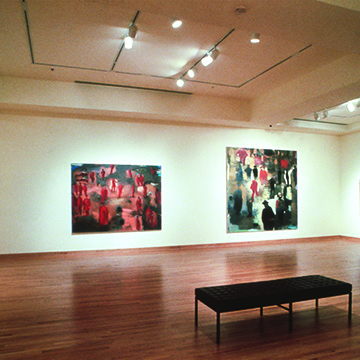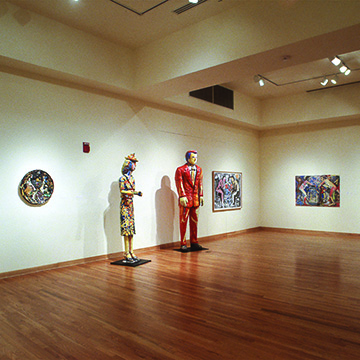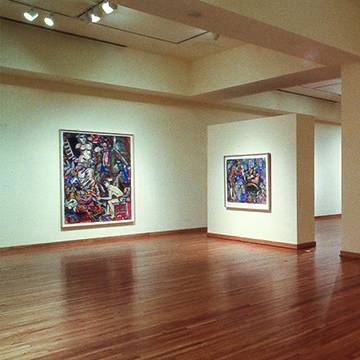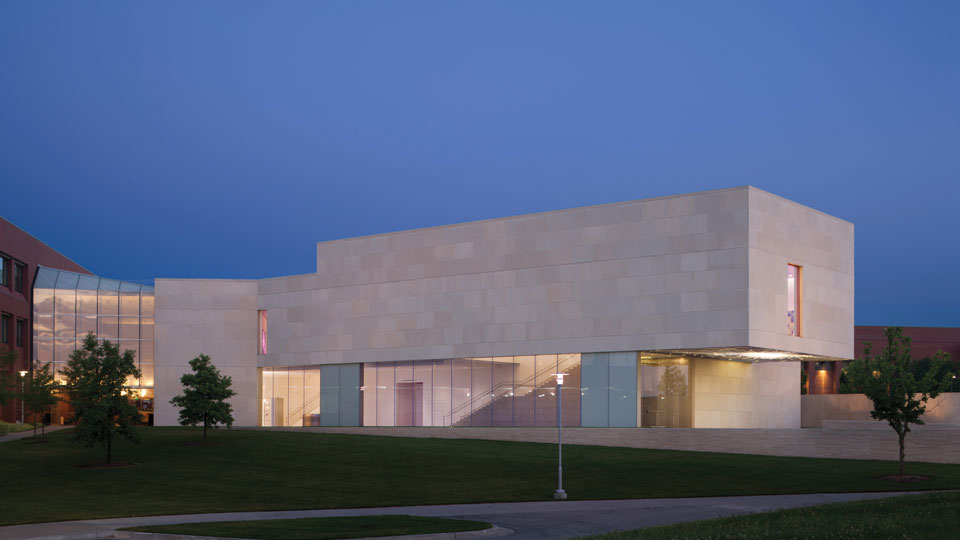The Figure · Two Bay Area Artists
Christopher Brown · Viola Frey
This exhibition features paintings, drawings and sculptures by San Francisco Bay Area artists Christopher Brown and Viola Frey. Brown will present a lecture on his work at 2 p.m. in Carlsen Center 211 as part of the opening reception.
Brown’s paintings in the JCCC exhibition include examples from several bodies of work. In The Striper’s Rise, figures appear to be standing in pools of water with their heads barely above the surface. Silhouetted against luminous bands of color that allude to the rippling surface of water, Brown’s “heads” shift between seeming transparency and solidity and are often echoed by shadowy reflections. These images appear both dreamlike and immutable and are simultaneously sensuous and disquieting.
For his most recent works, Brown used photographs taken during the Civil War and at Gettysburg during Lincoln’s address as his point of departure. The scenes he depicts are imagined from these blurry images discovered by Brown at the Library of Congress. They demonstrate the artist’s predilection for views from elevated vantage points and his preoccupation with figures in a crowd. A critic wrote of Brown’s latest paintings, “by linking the Civil War with the present, the artist also reminds us that civilization is always on the brink of crisis, and that once certain forces have been set into motion it may be impossible to derail them.”
Born in 1951 in Camp Lejeune, North Carolina, Christopher Brown received his BA in 1972 from the University of Illinois at Champaign-Urbana and an MFA from the University of California at Davis in 1976. Brown is currently Eminent Adjunct Professor of Painting and Drawing at the California College of the Arts. He served as a professor at the University of California at Berkeley from 1981-1994, where he was the chair of the art department from 1990-1994. His works are in major collections, including the Museum of Modern Art and the De Young Museum in San Francisco, California; the Walker Art Center of Minneapolis, Minneapolis; the Metropolitan Museum of Art, NY; the Modern Art Museum of Fort Worth, Texas; the Kemper Museum of Contemporary Art, and the Nerman Museum.
Well-known for her sculptures, Frey also has produced a significant body of dynamic, two-dimensional works that are the primary focus of the exhibition. Frey’s works on paper vividly demonstrate her prevailing interest in scale, color and emotional states. She immerses her figures in a world of objects and activity and employs intense color and radical shifts in scale to enliven her compositions. Her drawings express an exuberance and sense of invention, as well as narrative bent. Recurring motifs include doorways or windows (often with a grandmother figure peering through), images of figurines, classical sculptures and flowers. In her two-dimensional works, women are generally nude and are drawn from studio models. Her men, however, are often in suits – what Frey refers to as “power suits.”
Frey’s imposing larger-than-life figural sculptures transform the spaces they occupy and command immediate attention. Viewers experience a sense of unease with the hulking presence and unnatural colors of her figures. In both her drawings and works in clay, Frey’s figures appear isolated – seeming victims of the maelstrom of contemporary life. They pursue individual tasks and thoughts – apparently oblivious to the events swirling around them.
Viola Frey was born in 1933 in Lodi, California. She studied from 1952-3 at Stockton Delta College, California, and in 1956 she graduated with a BFA from the California College of Art and Crafts, Oakland. In 1958 she earned an MFA from Tulane University, New Orleans, Louisiana. Frey’s work has been exhibited internationally since the early 1960s in numerous major museums including the Whitney in New York; the San Francisco Museum of Modern Art, the Oakland Museum, and the Los Angeles County Museum of Art in California; and the Victoria and Albert Museum in London, and her work has been acquired for numerous important museum collections, including the Metropolitan Museum of Art, New York; the Museum of Fine Arts, Boston; the Nelson-Atkins Museum and the Nerman Museum.
We extend our sincerest thanks to the numerous individuals who assisted with the organization of the exhibit. In particular, we wish to thank Ed Gilbert of Gallery Paule Anglim, San Francisco; Jim Harris of Rena Bransten Gallery, San Francisco; Sique Spence of Nancy Hoffman Gallery, New York; Donald McNeil, curator, General Mills Inc., Minneapolis; and Rachel Wright, registrar, Museum of Modern Art of Fort Worth. Finally, we are indebted to the many private collectors who so generously loaned works from their collections. Without them, the exhibition would not have been possible.






